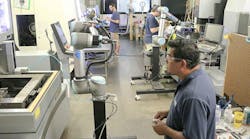As manufacturers of all sizes look to ramp up production again in the post-pandemic world, collaborative robots are definitely part of the equation. The ability to scale operations up – and down – quickly will be essential as demand uncertainty and the possibility of a return to high infection levels characterize the coming months.
But where to begin?
In this post, we look at the A to Z of specific tasks for which cobots are ideally suited and examine how and why it makes sense to automate.
CNC Machine Tending
The high capital cost of CNC machines makes it imperative that the machines are kept loaded and running as much as possible. Cobots can perform all or parts of the typical CNC tool process tending steps: placing material in the machine, closing the door, activating the machine, opening the door when the machining is complete and removing the finished machined part.
Gluing, Dispensing and Welding
Cobots are well-suited for this type of work which requires accurate and repeatable motion of tools such as a welding tip or adhesive applicator tip, at every point on the path along the work pieces.
Injection Molding Machine Tending
As with CNC machines, molding tooling is expensive. Typical tasks involve removing the entire molded piece from the mold after plastic injection and cooling, trimming flashing or cutting production parts.
Lab Analysis and Testing
When it comes to testing of all kinds, careful adherence to regulatory and/or internal lab policies is paramount to ensuring repeatable, trusted and calibrated results. When commercial and private labs deploy cobots to perform routine tasks such as the application of chemical reagents, mixing, placement into incubators or freezers, moving treated or untreated samples in part or in whole, they:
Packaging and Palletizing
These tasks both involve repetition, lifting heavy loads, and thought about where and how to optimally place packages of different sizes and weights. Studies have shown workers’ error rates rise and attention span falls after a couple of hours of straight repetitive work, making cobots the ideal partner for this type of work.
Pick and Place
At its simplest, pick and place tasks are those which require an object to be picked up from one location and placed in another specific location. Repetitive mundane tasks can create worker boredom and inattention, leading to errors and lower throughput.
Most polishing steps require use of a buffing tool with a rotating pad and chemical agent, moved around to remove surface defects, impart a smooth surface for further processing or as a final cosmetic step. The repetitive nature of this task, coupled with the need for consistency and repeatability make it ideal for cobot automation; typical results include:
Quality inspection
Products typically undergo cosmetic optical inspection, or a metrology inspection step (dimensional and/or electrical and/or operational), or both. Regardless of the complexity required, cobots can:
Screw and nut driving
Frequently these steps involve multiple positions, directions and heights, and torques delivered to the screws or nuts. It may be difficult to achieve consistent, high quality results with these repetitive tasks and employees may face ergonomic challenges when they handle bulky and heavy tools to repetitively drive screws and nuts during the production process.
What Cobots Deliver
Cobots have the potential to:
- Improve productivity
- Lower insurance and absentee costs caused by repetitive stress injuries; injuries caused by human interference with moving machine parts; and exposure to hazardous gases and hot, moving surfaces
- Improve quality and its corollary: customer satisfaction
- Increase flexibility to handle demand spikes with off-shift automated manufacturing with cobots
- Reduce scrap rates
- Improve throughput, accuracy, yield and capacity.
- Increase capacity, scalability and flexibility to manage demand spikes with off-shift production
Application-centric cobots are here today and ready to go to work. Advances in hardware and software combine to accelerate the path to automation, improve productivity and efficiency, lower costs and ensure the flexible workforce needed to get back to “normal” – whatever that will look like.
Jim Lawton is vice president of product and applications management at Universal Robots.




